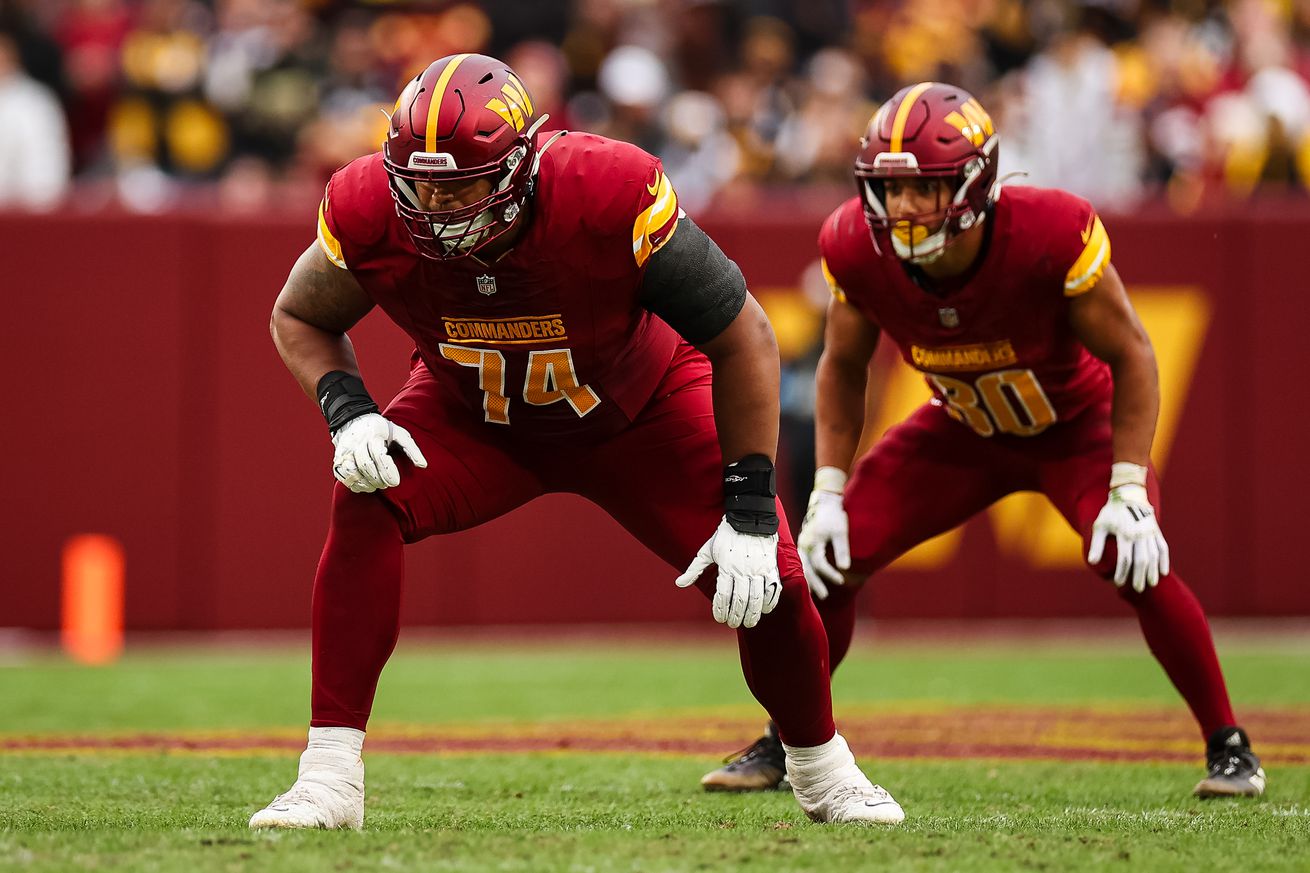
Comparing Coleman’s rookie season to recently drafted left tackles
This is the second of two articles that asks how third round pick, Brandon Coleman is progressing at left tackle in his rookie season with the Washington Commanders.
The first article, published last week, asked:
When Will the Commanders Know if Brandon Coleman is the Answer at Left Tackle?
That article took a look at all of the left tackles drafted from 2017 through 2021 who have earned second contracts as starters with their drafting teams, or who are still starting in their fourth seasons or later. Three of the LTs performed at the level of average to elite starters as rookies. They were all drafted in the top 23 picks of the first round. The others allowed more pressures in pass protection during their rookie seasons than teams would like to see from their starters. By the second season, all but one had got their Pressure Rate down below 5% of dropbacks, which is indicative of a quality starter.
The sample of players examined in the previous article was selected from a larger number of drafted OTs, many of whom never became starters, or started for a few seasons before transitioning to other positions, backup roles or out of the league. In selecting that sample, I discovered some very useful rules of thumb. OTs who consistently stay below 5% Pressure Rate in pass protection, tend to get locked up long term by their teams. OTs with Pressure Rates in the range from 5-6% tend to find work as starters, but their futures are less secure. And those who don’t get below 6% tend not to stick as starters.
In this article, we will have a look at how Coleman has progressed in pass protection throughout his rookie season compared to other recently drafted OTs who succeeded at the position.
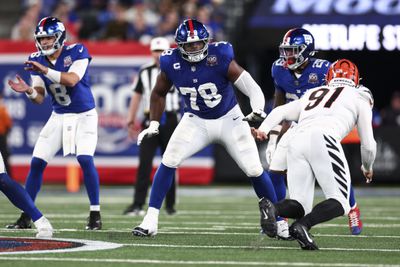
Photo by Kevin Sabitus/Getty Images
Other Successful LTs Had Rocky Starts
As part of the research for the weekly Stats and Snaps articles, I have been tracking Coleman’s performance in pass protection throughout his rookie campaign. Through the first six games, he was allowing alarmingly high rates of pressure. That had me worried, until I looked at the rookie seasons of other recently drafted LTs who have become successful starters. That is what gave me the idea for this and the previous article.
To illustrate what I mean, the following graph plots the weekly performance in pass protection of four of the players profiled in the previous article in their first seasons starting. These players were selected from the group who struggled initially and improved in their second seasons. As you will see, these players exhibited a characteristic week-to-week performance profile:
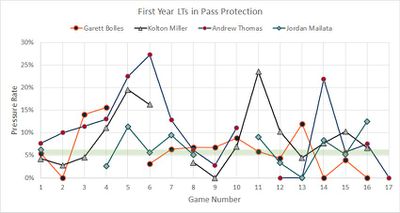
Each of these players exhibited peaks of poor performance, often lasting for several games, interspersed between stretches of one to three games where they allowed less than 5% pressure rates. An apt description of these players’ first seasons is rollercoaster ride. If you squint, you might notice that the number of games below 6% tended to increase after around Week 10. It’s not a strong effect.
When rookie LTs are bad, they can be very bad. All four players had multiple games allowing pressure on more than 10% of dropbacks. And three of the four had games over 15%. The worst of the four was Giants’ LT Andrew Thomas, who was a turnstyle during his first seven games. Bear in mind, all four of these players developed into quality starting LTs.
The Eagles’ Jordan Mailata had the best first season of the four. His path to becoming an NFL starter was different from the others. He entered the NFL through the International Players Pathway, and had never played a down of American football when he was drafted in the seventh round in 2018. The Eagles kept him on the roster as a developmental project for two years before he took his first NFL snap a starter in 2020. He is the reason I keep referring to players’ first seasons rather than their rookie seasons.
Brandon Coleman’s Rookie Season
The following graph plots Brandon Coleman’s performance in pass protection in each game this season in which he has played a minimum of 8 pass blocking snaps. To facilitate comparison with the previous four players, I kept the vertical scale identical to the previous graph. Numbers of pass blocking snaps in each game are shown next to the data points.
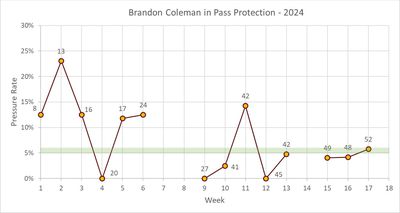
Coleman’s rookie season has differed from all the other LTs profiled in these two articles in a key respect. Each of the other LTs became full time starters from Day 1, or early in their rookie seasons. In contrast to the usual pattern, the Commanders’ coaching staff eased Coleman into the starting role by having him alternate series on offense initially with veteran LT Cornelius Lucas. He only became the full time starter LT in Week 10 game against the Steelers.
Just like the previous four players, Coleman’s first season at LT has been something of a rollercoaster ride. In the first six games, he took QB Jayden Daniels over some big bumps and dips, allowing pressures on an average of 12.5% of dropbacks, more than twice the rate allowed by a quality starter.
Fortunately, Jayden Daniels is good at evading pressure, so the pressures allowed only translated into two sacks and two QB hits during the steep part of Coleman’s learning curve. The coaching staff also limited Daniels’ exposure by alternating series with Lucas while Coleman was learning the ropes.
Coleman’s worst game in pass protection so far was in Week 2 against the Giants, in which he allowed 2 QB hits and 1 hurry on just 13 pass blocking snaps, equating to a Pressure Rate of 23.1%.
Since returning from injury in Week 9 and becoming the full time starter in Week 10, Coleman’s good games have well outnumbered the bad. The only really bad game in this stretch was in Week 11 against the Eagles ,when he allowed 2 sacks and 4 hurries. He has had three games this season in which he did not allow any pressures: Week 4 Cardinals, Week 9 Giants, Week 12 Dallas.
Aside from the first Eagles game, he has been under 5% Pressure Rate in every game from Week 9, until the Sunday Night game against the Falcons, in which he allowed 1 sack and 2 hurries in 52 dropbacks (5.77% Pressure Rate). While that performance was a slight step back from what we have come to expect, it was not a particularly bad day for a rookie OT.
Bottom Line: While it is still too early to pronounce Coleman the long term solution at LT, his progression in pass protection throughout his rookie campaign has been promising in comparison to other recently drafted LTs who have earned long term extensions.
How Coleman Compares to the Rest of the Rookie Class
There was a lot of discussion on Hogs Haven in the offseason about whether the Commanders had done enough to shore up the OT position. Adam Peters’ decisions to roll with returning veterans Cornelius Lucas (LT) and Andrew Wylie (RT) to start the season and waiting until the third round to draft Brandon Coleman were somewhat controversial. Was it a mistake not to draft an OT earlier? Let’s see how the rookie OT class stacks up, heading into Week 18.
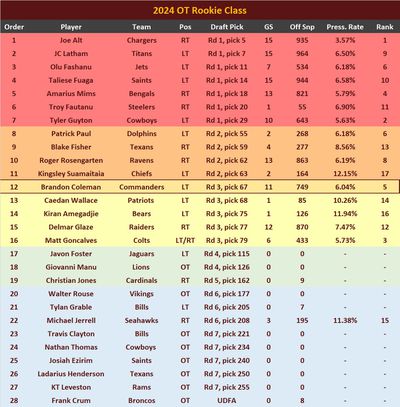
Brandon Coleman was the 12th OT drafted in 2024, excluding Jordan Morgan who was drafted 25th overall by the Packers and switched to guard. Through Week 17, Coleman has played in 15 games for the Commanders, starting 11, exclusively at LT. He left the Week 7 Panthers game early with an injury and did not play the following week against the Bears. In 447 pass blocking snaps, he has allowed 8 sacks, 2 QB hits and 17 hurries, for a total Pressure Rate of 6.04%.
Playing Time: Coleman has played the 7th most blocking snaps and started the 7th most games among rookie OTs. Among rookies who have got significant playing time at LT, he ranks 3rd in playing time and games started.
Pass Protection: Within the rookie OT class overall, Coleman has allowed the 5th lowest Pressure Rate in pass protection. Among rookie LTs, he has the 2nd lowest Pressure Rate. Counting Matt Goncalves as an LT would drop him to 3rd place.
Limiting the sample to OTs with a minimum of 200 pass blocking snaps, to ensure more reliable estimates, does not change the rankings.
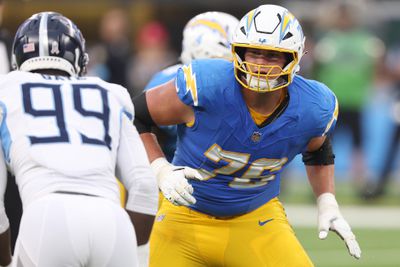
Photo by Sean M. Haffey/Getty Images
Revisiting the 2024 Offseason
While fans were debating how urgently the Commanders should address the OT situation last offseason, I published an article that investigated the probability of drafting an OT who is an upgrade to Lucas or Wylie as a rookie. That analysis found that the hit rate for drafting OTs in the first round who are better than Wylie in pass protection in Year 1 was around 40%. In round 2 it dropped to 25%. After that it was below 10% in every round.
The Commanders used their first round pick on Jayden Daniels. In order to draft an OT who was a significant upgrade to Cornelius Lucas (2024 Pressure Rate: 4.40%) or Andrew Wylie (2024 Pressure Rate 5.10%) in pass protection this season, they would have needed to use the second overall pick to get ahead of the Chargers and draft Notre Dame’s Joe Alt.
Was it a mistake not to trade back into the first round to draft an OT?
There were rumors that the Commanders attempted a trade in the first round, but there have been no substantiated reports with details of any trade offers. Consequently, suggestions that the front office let the team down by not trading up were nothing more than idle speculation. Nevertheless, had an offer been made, the Commanders could have achieved a modest improvement over Coleman by dealing for Tyler Guyton or Amarius Mims. What such a deal might have cost, in terms of draft capital, we may never know.
One player whose name came up on HH during the draft was Washington Huskies LT Troy Fautanu, who went 20th overall to the Steelers. Fautanu started the Week 2 game at RT before going to injured reserve with a knee injury. It is impossible to say if he might have been an upgrade this season, since it takes hundreds of reps to get a meaningful handle on blocking performance. The same goes for Kingsley Suamaitaia, Caedan Wallace, Kiran Amegadjie, and every OT drafted after the third round. Patrick Paul and Blake Fisher are right on the cusp of having enough playing time for blocking stats to become reliable.
Should the Commanders have drafted an OT earlier?
If we accept that drafting Jayden Daniels was the right decision and that trading up does not appear to have been a good option, the next question becomes whether the Commanders should have drafted an OT in the second round.
The Commanders made three selections in the second round: DT Johnny Newton #36, CB Mike Sainristil #50, TE Ben Sinnott #53. The latter two were acquired in a swap with the Eagles for the Commanders’ 40th overall pick. Could the Commanders have drafted a better OT than Coleman with one of their earlier picks?
At pick #36, there was one OT on the board who has had a moderately better rookie season in pass protection than Coleman. That player is the Colts’ Matt Goncalves, who was picked later in the third round and has played substantial snaps in 4 games at LT (Weeks 9-12) and 4 games at RT (Weeks 13-17). Goncalves, like Coleman, appears to be one of the rare late Day 2 picks with early starting potential at OT. He was not a frequent mention on HH as an option for the Commanders in the second round at the time of the draft.
The player who received the most attention in these pages at draft time was LT Kingsley Suamataia. Suamataia is a player I liked for the Commanders early in the draft process. He profiled as a raw developmental prospect, with tremendous athletic upside. Suamataia was selected 63rd overall by the Chiefs as a potential replacement for retired 2023 starting LT Donovan Smith and an upgrade over 2023 3rd round pick, Wanya Morris. Suamataia started the first two games for the Chiefs at LT, and was benched after making critical mistakes in the Week 2 game against the Bengals. He was replaced at LT by Morris. He got another opportunity to start at LT in the Week 10 game against Denver, and allowed 1 sack, 3 QB hits and 7 total pressures. He has played 2 snaps on offense since that game.
It would appear that the Commanders’ front office made very effective use of draft resources to address the OT position, after having used their first pick in the draft on a QB.
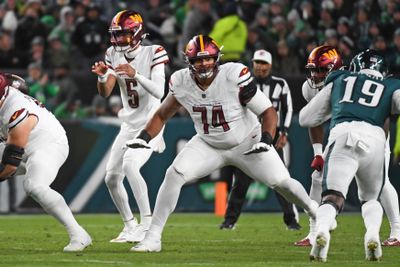
Eric Hartline-Imagn Images
Conclusions
At the 17 week mark of his rookie season, Brandon Coleman is showing signs of being one of the best players overall in a deep OT draft class. Comparison to other LTs who became long term starters after struggling as rookies suggests that he is progressing well toward providing a solution at the most important position on the offensive line.
Of course, it is still early to judge draft picks, particularly players selected after the early rounds. Coleman’s Pressure Rate in pass protection across his entire rookie campaign is higher than expected for a quality starter. But he has improved in recent games after his initial struggles. If he continues to improve next season, he could become a key piece of the rebuild and represent an exceptional value for his draft position. Based on the developmental timeline of recently drafted players at his position, the Commanders should have a good idea of whether they have found a franchise LT by the end of next season.
To achieve a substantially better outcome in pass protection this season, the Commanders would have needed to forgo drafting Jayden Daniels to select Joe Alt instead, or would likely have needed to put together a massive trade package to move back into the top 5 for an OT. None of the other OTs drafted between Alt and Coleman is more than half a percentage point ahead of Washington’s rookie LT in Pressure Rate. It will be a few years before we know which OTs were really the best long options at Washington’s draft picks. Based on results to date, it is hard to fault the Commanders’ draft decisions.